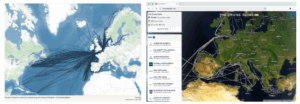Crown Court Judge claims “CCTV surveillance in slaughterhouses is inadequate” countering Government report claiming mandatory CCTV in slaughterhouses has reduced incidents of cruelty

Following the release of a Government report concluding that mandatory CCTV in English slaughterhouses has reduced the number of animal welfare non-compliances by 11%, animal advocates have spoken out today to express disagreement and concern.
Urging consumers to “be aware that animal abuse remains rife in slaughterhouses”, NGOs Animal Justice Project and Animal Equality point to a series of covert investigations that have taken place since CCTV was mandated by law in 2018, evidencing extreme and regular animal welfare abuses that had not been detected by the video surveillance cameras, or acted upon by authorities.
Under the Mandatory Use of Closed Circuit Television in Slaughterhouses (England) Regulations 2018, all slaughterhouses in England are required to install and operate a CCTV system in all areas of the slaughterhouse where live animals are present, such as where they are unloaded, kept, handled, stunned and slaughtered. The regulations came about following a Government consultation in 2017 and were prompted by a number of cases of covert video footage revealing deliberate animal cruelty in slaughterhouses, including in premises where CCTV was already voluntarily installed. 99% of the consultation’s 4000 respondents were in favour of implementing camera surveillance by law.
A ‘post-implementation review’ into the impact of regulatory CCTV was produced by the Government’s Department for Environment, Food & Rural Affairs (Defra) and commenced in November 2022. Organisations invited to take part in the private consultation included animal protection groups, such as Animal Equality and Animal Aid, as well as veterinary associations, accreditation schemes, supermarkets and industry bodies. Those consulted were invited to comment on a number of lines of enquiry, including whether mandatory CCTV has ‘helped provide assurance that all slaughterhouses are operating to high welfare standards’, whether there ‘has been a reduction in animal welfare issues’ as a result and if its introduction has ‘led to benefits in animal welfare’, as well as a number of operational questions relating to cost of installation, form filing, and training.
Defra’s review, released this month, concludes that CCTV has improved compliance in slaughterhouses and deterred wrongdoing, but animal advocates and lawyers have expressed strong disagreement.
Ayesha Smart, barrister at Exchange Chambers and Britain’s youngest ever ethnic minority Crown Court judge, says: “Only around 10% of slaughterhouse non-compliances are identified either by live or retrospective CCTV viewing – this correlates with my experience, that in fact the number of referrals for prosecution or prosecutions for animal abuse hasn’t drastically changed i.e. gone down. Without routine auditing of footage, compliance with animal welfare standards isn’t always taken as seriously. The framework around current CCTV surveillance in slaughterhouses is inadequate and perpetrators of animal cruelty are not routinely being adequately brought to justice.”
By law, the Food Standards Agency is required to monitor both live and historical CCTV footage on a regular basis every operational day, as well as non-operational periods on an ad hoc basis. The regulation dictates that ‘at least 15 minutes of footage’ must be viewed.
Despite these spot checks, last month, UK-based charity Animal Justice Project released harrowing footage of pigs hit with paddles inside a Morrisons abattoir. The NGO argues this daily occurrence happened in full view of CCTV, yet nothing was being done to prevent it because CCTV is not watched as the norm in slaughterhouses.
In a 2022 report co-authored by Animal Equality UK and The Animal Law Foundation, an analysis was conducted into the footage obtained from covert investigations inside slaughterhouses. A multitude of severe animal welfare abuses were detected, despite CCTV being in place, including violent handling, animals being live-plucked, routine equipment failures, animals being left to suffocate, piglets being thrown into boiling water without checks for vital signs and other legal violations. Despite this, one-third of cases resulted in no formal action being taken.
In November 2020, Animal Justice Project investigated an abattoir operated by Gressingham Foods, filming ducks who were left shackled upside-down for 14 minutes. The maximum legal allowance is two minutes. The group says it is another example where abuse and illegalities were taking place in the presence of CCTV. Upon receiving footage from the NGO, and despite obtaining the slaughterhouses’ own CCTV footage corroborating the group’s findings, the Food Standards Agency did not pursue a prosecution, believing it ‘not to be in the public interest’.
Animal protection organisations also highlight the lack of compliance in implementing the CCTV regulations – an issue also acknowledged within Defra’s review which notes that there were also 98 instances of non-compliance in adequately implementing the surveillance requirements. In December 2019, Animal Justice Project released harrowing footage from a free-range turkey farm, Pastures Poultry, whereby birds were plucked alive and conscious chickens were thrown into boiling water; the site did not have CCTV in place, a clear breach of the law.
Following a string of similar cases and implementation issues, in 2021 The Times ran an article entitled ‘Abuse at abattoirs is caught on video but no one watches it’. The Government has previously admitted that review of CCTV footage is ‘intermittent, selective and periodic’ and the Food Standards Agency disclosed recently that it has seen ‘numerous incidences of losses of CCTV data when it has been requested for potential enforcement’.
Claire Palmer, Founder of Animal Justice Project, says: “Time and time again, animal cruelty and abuse is often uncovered by NGOs like Animal Justice Project, which forces the Food Standards Agency to watch slaughterhouse CCTV footage in its entirety for that specific time-period, however even then there is no guarantee action will be taken. We believe this is creating a culture of animal abuse amongst slaughterhouse staff, who know they can essentially do what they like to animals and get away with it.”
Abigail Penny, Executive Director of Animal Equality UK, says: “CCTV in its current form is little more than a smokescreen. These surveillance laws came into play after animal organisations like Animal Equality released sickening footage of abuse occurring within slaughterhouses, yet our concerns are still not being heard. There is little point in capturing reams of footage that is held by the facilities who carry out the misconduct, the majority of which is not looked at by officials, and when cruelty is captured it typically leads to no meaningful legal action. Cameras won’t save animals, but consumers can, by choosing plant-based options instead.”
Sophie Peutrill, Head of Programmes at The Animal Law Foundation said: “The recent review of CCTV in slaughterhouses is not only a missed opportunity to explore ways to improve the application of animal welfare law, but it also fails to even acknowledge the flaws within the current system. Whilst CCTV in slaughterhouses is welcome and the current system is better than nothing, it has not managed to solve the enforcement problem of animal welfare laws, where inspections and prosecutions for crimes causing extreme suffering remain shamefully low. Footage remains with the slaughterhouses unless requested, meaning that if it is not requested no one will ever see the potential crime. The footage also only needs to be held for a short period of time and even then the FSA has reported that footage has gone missing. It is vital animal welfare law is applied in practice and CCTV should be one of the tools available to ensure that.”




